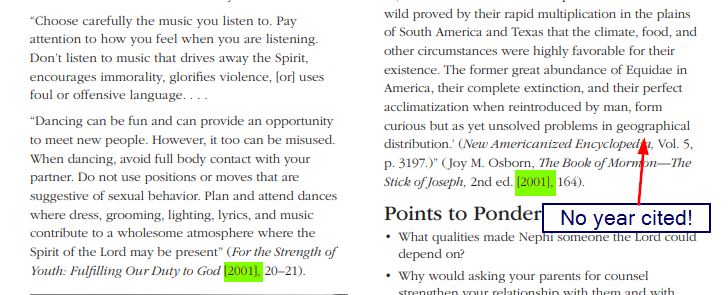If I could ask them one question . . . Come Follow Me, Lesson 5
Posted: Sun Jan 26, 2020 8:45 am
Come Follow Me, lesson 5, Jan. 27 - Feb. 2, 1 Ne 16-22
Annotated BoM starting at 1 Nephi 16
If I wanted to encourage thought and try to understand devout believers better, I might ask:
"Can you think of a good reason to say there were horses in the Americas in Book of Mormon times?"
(as in 1 Ne 18:25)
Things to consider:
Trivia:
The phrase "came to pass" is used 31 times in 1 Ne 16. With only 39 verses, the phrase is used once every 1.26 verses on average in this chapter. The phrase "came to pass" is used 1,355 times in the book, so the phrase is used 5.67 times per chapter on average, or once every 4.87 verses on average. (This does not include "come to pass" or other variations of the phrase, but they are few compared to the number of times "came to pass" is used.)
Have fun studying!
Annotated Book of Mormon
Previous Lessons
Annotated BoM starting at 1 Nephi 16
If I wanted to encourage thought and try to understand devout believers better, I might ask:
"Can you think of a good reason to say there were horses in the Americas in Book of Mormon times?"
(as in 1 Ne 18:25)
Things to consider:
- Anachronism: a person or a thing that is chronologically out of place (Merriam-Webster)
- Merely one anachronism can prove a document is not from the time frame it claims. For example, if we had a document claiming to be from 1979 that mentioned the Space Shuttle Challenger explosion and deaths, we could correctly reject that it was from 1979 because the Space Shuttle Challenger disaster occurred in 1986. In fact the first Space Shuttle flight didn't occur until 1981.
- The Book of Mormon claims to be written by and about inhabitants of the Americas between roughly 2000 BCE until 421 CE.
One thing these Book of Mormon writers observe in the Americas during this time is horses. - There were no horses in the Americas during the claimed time frame of the Book of Mormon.
- Some apologists speculate that perhaps Joseph was referring to some other animal that he was unfamiliar with, so he used the name of an animal he knew, "horse" in this case. This is described as using a loanword for the unfamiliar thing being translated. This does not fit the description given by the Church of how the book was translated from reformed Egyptian characters to English word-for-word and would require that God be the source of the confusion for the word in question ("Book of Mormon Translation").
- Furthermore, we have examples of animals and plants that Joseph was unfamiliar with for which God apparently gave Joseph a name instead of Joseph presuming the right to usurp God by using a loanword (plants: neas and sheum in Mosiah 9:9 and animals: cureloms and cumoms of Ether 9:19), so this apologetic of using loanwords is awkward considering the claim that an all-knowing God was in charge of the translation. From the Book of Mormon examples of plants and animals that no one can identify, God clearly didn't need loanwords, and using such loanwords has been the source of confusion and speculation for believers.
- If the Church were comfortable with the loanword speculation, we would expect it to use it commonly. Instead, the issue is usually ignored. Other times the Church may offer another explanation. For example, for the 1 Ne 18:25 mention of horses, the current Book of Mormon Student Manual for Religion 121-122 explains on page 40 that, “There was controversy regarding horses in the Western Hemisphere before Columbus arrived. However, modern archaeological discoveries have shed new light on the subject.” It then quotes from the New Americanized Encyclopedia that: “Fossil remains of true horses . . . are found abundantly in deposits of the most recent geological age, in almost every part of America. . . In that continent however, they became quite extinct, and no horses, either wild or domesticated, existed there at the time of the Spanish conquest.” And, then the article explains that this is a “curious but as yet unsolved problems in geographical distribution.”
- There seem to be multiple editions of the New Americanized Encyclopedia, but they seem to be published in the early 1900s, maybe as late as 1903. Based only on this citation from more than 100 years ago, one could speculate that perhaps pre-Columbian American horses went extinct in the Americas after the Book of Mormon timeline.
- However, there is no recent controversy whether horses were in the Americas during the time reported in the Book of Mormon. Horses became extinct in the Americas by 8,000 years ago. That’s 4,000 years or more before the Book of Mormon Jaredites, and horses were not reintroduced in the Americas until Europeans brought them back more than 1,000 years after the claimed destruction of the Nephites.
- Why use an obscure, scientifically ancient, ambiguous source like this as context for the mention of horses in the Book of Mormon?Does anything about Book of Mormon horses or the explanations for them offered by Mormon apologists or by the Church fit the work of a God who works after the manner of plainness (2 Ne 31:3)?
- Why would the Church and its apologists give us these speculations when prophets have warned not to teach, "the philosophy of men mingled with a few scriptures" (Apostle Ezra Taft Benson here)?
Trivia:
The phrase "came to pass" is used 31 times in 1 Ne 16. With only 39 verses, the phrase is used once every 1.26 verses on average in this chapter. The phrase "came to pass" is used 1,355 times in the book, so the phrase is used 5.67 times per chapter on average, or once every 4.87 verses on average. (This does not include "come to pass" or other variations of the phrase, but they are few compared to the number of times "came to pass" is used.)
Have fun studying!
Annotated Book of Mormon
Previous Lessons

